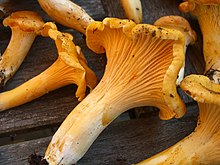| Cantharellus formosus | |
|---|---|

| |
| Scientific classification | |
| Domain: | Eukaryota |
| Kingdom: | Fungi |
| Division: | Basidiomycota |
| Class: | Agaricomycetes |
| Order: | Cantharellales |
| Family: | Cantharellaceae |
| Genus: | Cantharellus |
| Species: | C. formosus
|
| Binomial name | |
| Cantharellus formosus | |
| Cantharellus formosus | |
|---|---|
| Ridges on hymenium | |
| Cap is infundibuliform | |
| Hymenium is decurrent | |
| Stipe is bare | |
| Spore print is yellow to white | |
| Ecology is mycorrhizal | |
| Edibility is choice | |
Cantharellus formosus, commonly known as the Pacific golden chanterelle, is a fungus native to the Pacific Northwest region of North America. It is a member of the genus Cantharellus along with other popular edible chanterelles. It was distinguished from C. cibarius in the 1990s. It is orange to yellow, meaty and funnel-shaped. On the underside of the smooth cap, it has gill-like ridges that run down onto its stipe, which tapers down from the cap. The false gills often have a pinkish hue. It has a mild, sweet odor.
It appears solitary to gregarious in coniferous forests, from July to December. It is a choice edible mushroom and Oregon's state mushroom.